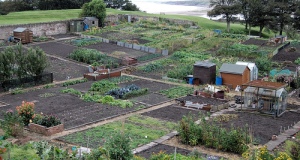 It’s no secret that Britain has seen a lot of rain recently. In fact some parts of the UK have just experienced their wettest January since records began, and allotments nationwide are waterlogged or completely submerged. It’s almost a blessing in disguise that the wet weather occurred when it did. Very few gardeners have crops in the ground at this time of year, and most are simply maintaining and preparing for the rapidly approaching growing season. So firstly let’s all count our blessings. The summer floods in 2012 hit at the height of the growing season, causing incredibly severe damage and financial loss for many gardeners.
It’s no secret that Britain has seen a lot of rain recently. In fact some parts of the UK have just experienced their wettest January since records began, and allotments nationwide are waterlogged or completely submerged. It’s almost a blessing in disguise that the wet weather occurred when it did. Very few gardeners have crops in the ground at this time of year, and most are simply maintaining and preparing for the rapidly approaching growing season. So firstly let’s all count our blessings. The summer floods in 2012 hit at the height of the growing season, causing incredibly severe damage and financial loss for many gardeners.
Firstly if your allotment was flooded and you had edible crops in the ground close to harvest, then dispose of them immediately. A great deal of flood water would have contained sewage and the possibility of contamination, and it’s better to be safe than sorry. Fruit and vegetables that are eaten raw should be avoided for at least 6 months. This will give the plant enough time to recover and for any contaminants to break down naturally. Root vegetables such as carrots and parsnips, and edible fruit from trees above the flood water should be safe to eat in just a few weeks, but make sure you boil any root vegetables thoroughly before consumption. Any plants that are left should be covered with garden fleece as they will quickly perish in waterlogged soil during the last remaining frosts. The frost fleece will create a microclimate underneath which will raise the ground temperature enough to allow your plants and their roots to survive.
Any debris that’s been left on your plot now that the waters have receded must be cleared away, either with your household rubbish or through a waste disposal site run by your local council. Then dig everything over, and leave it to dry out. Planting anything at this stage will likely be a waste of time as seeds will tend to rot before they have a chance to germinate, and the torrential rain will have flushed away any nutrients in the soil leaving it relatively infertile. With intermittent rain forecast for the next few weeks this may take some time, so sow seeds in trays at home until the soil is dry enough to be worked. If you’re short on space, then you may have to buy juvenile plants from garden centres in mid spring ready for planting. Once the soil has dried out sufficiently it’s worth digging in some fertiliser and mulch. However avoid doing this early as you risk polluting water courses.
It’s highly unlikely that any allotments will experience lasting flood damage, and most will be ready to plant in just a few days once the risk of flooding has passed. Most of the work to be done now is preventative, and work to protect your plot should we experience any more prolonged periods of severe weather. Before you start planting for this years growing season, invest in a good quality mulch fabric. Many gardeners use polythene for weed control which works well, but if you’re in an area prone to flooding you could prevent excess rain water from draining away by using a waterproof plastic sheet. Landscape fabric will prolong the life of your mulch, whilst efficiently preventing any unwanted vegetation. This type of garden ground cover is ideal for raised beds, however if you plant in rows then a heavier duty 100gsm fabric will be far more convenient as it will be able to withstand the stress of people walking between plants.
Luckily the best way of promoting good drainage is the reason you have an allotment in the first place. Plants are very effective at removing and using excess rain water, in fact an average baking potato needs 10” of water over its entire surface area to promote a healthy crop. So it’s important to make sure your plants stay healthy with regular maintenance and pest control. Remove any dead leaves and debris once a week at least, and make sure you invest in a good quality pesticide. Just make sure it’s safe to use on edible crops. I’d also recommend a close weave insect netting to prevent damage from flying insects. A mesh size of around 0.5mm will form an effective barrier against aphids and root flies, whilst also preventing intrusion from larger animals like birds and rabbits. You’ll find that most polyethylene netting is light enough to lie directly on most plants, or you could use a crop cage. It’s also worth burying the edge to ensure you have formed an impenetrable barrier.
Plants aside it’s just as important to protect equipment, pesticides and fertilizers from excessive rain. If you have a shed on your plot, then ensure it’s watertight with the aid of a heavy duty tarpaulin if necessary. If your shed has an electricity supply then make sure it’s turned off before periods of heavy rain, and have it extensively checked by a qualified electrician before switching it back on.
